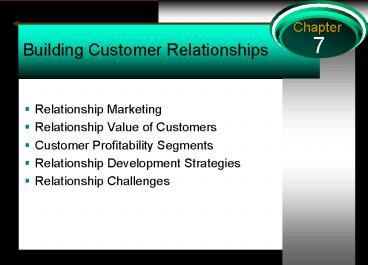Building Customer Relationships - PowerPoint PPT Presentation
1 / 22
Title:
Building Customer Relationships
Description:
easier jobs for employees. social benefits for employees ... Customer Intimacy- Home Depot, Ritz Carlton. Level 4 Structural Bonds. Information Exchange ... – PowerPoint PPT presentation
Number of Views:55
Avg rating:3.0/5.0
Title: Building Customer Relationships
1
Building Customer Relationships
Chapter
7
- Relationship Marketing
- Relationship Value of Customers
- Customer Profitability Segments
- Relationship Development Strategies
- Relationship Challenges
2
Relationship Marketing
- is a philosophy of doing business, a strategic
orientation, that focuses on keeping current
customers and improving relationships with them - does not necessarily emphasize acquiring new
customers - is usually cheaper (for the firm)
- keeping a current customer costs less than
attracting a new one - thus, the focus is less on attraction, and more
on retention and enhancement of customer
relationships
3
Figure 7.1Customer Goals of Relationship
Marketing
4
Benefits of Relationship Marketing
- Benefits for Customers
- Receipt of greater value
- Confidence benefits
- trust
- confidence in provider
- reduced anxiety
- Social benefits
- familiarity
- social support
- personal relationships
- Special treatment benefits
- special deals
- price breaks
5
Benefits of Relationship Marketing
- Benefits for Firms
- Economic benefits
- increased revenues
- reduced marketing and administrative costs
- regular revenue stream
- Customer behavior benefits
- strong word-of-mouth endorsements
- customer voluntary performance
- social benefits to other customers
- mentors to other customers
- Human resource management benefits
- easier jobs for employees
- social benefits for employees
- employee retention
6
Figure 7.2Profit Generated by a CustomerOver
Time
Source An exhibit from F. F. Reichheld and W. E.
Sasser, Jr., Zero Defection Quality Comes to
Services, Harvard Business Review,
SeptemberOctober 1990.
7
Customer Loyalty Exercise
- Think of a service provider to who you are loyal.
- What do you do (your behaviors, actions,
feelings) that indicates you are loyal? - Why are you loyal to this provider?
- What factors have influenced the formation of
your loyalty?
8
A Loyal Customer is one who
- Show Behavioral Commitment
- Buys from one supplier (sole loyalty)
- Buys a large proportion, increasingly buys more
- Provides constructive feedback/suggestions
- Exhibits Psychological Commitment
- Commitment-doesnt consider terminating the
relationship - Has a positive attitude toward
- Say good things about
9
Figure 7.5 Relationship Development Model
Customer Benefits Confidence benefits Social
benefits Special treatment benefits
Relationship Bonds Financial bonds Social
bonds Customization bonds Structural bonds
Strong Customer Relationship (Loyalty)
Core Service Provision Satisfaction Perceived
service quality Perceived value
Firm Benefits Economic benefits Customer behavior
benefits Human resource management benefits
Switching Barriers Customer inertia Switching
costs
10
Strategies for Building Relationships
- Core Service Provision
- service foundations built upon delivery of
excellent service - satisfaction, perceived service quality,
perceived value - quality in the core service
- Segmentation and Targeting
- Traditional Segmentation
- Focus and Competitive Advantage
- Not worth the effort
- Profitability Segments
- USA Today Article
11
Figure 7.4The Customer Pyramid
Most profitable customers
What segment spends more with us over time, costs
less to maintain, spreads positive word-of-mouth?
Platinum
Gold
Iron
What segment costs us in time, effort and money
yet does not provide the return we want? What
segment is difficult to do business with?
Lead
Least profitable customers
12
The Customer Is NOT Always Right
- Not all customers are good relationship
customers - wrong segment
- not profitable in the long term
- difficult customers
13
Strategies for Building Relationships
- Switching Barriers
- customer inertia
- switching costs
- set up costs, search costs, learning costs,
contractual costs, - Perceived risk
14
Strategies for Building Relationships
- Relationship Bonds
- financial bonds
- social bonds
- customization bonds
- structural bonds
15
Figure 7.6 Levels of Relationship Strategies
Stable pricing
Bundling and cross selling
Volume and frequency rewards
1. Financial bonds
Integrated information systems
Continuous relationships
Excellent service and value
2. Social bonds
4. Structural bonds
Personal relationships
Joint investments
Shared processes and equipment
Social bonds among customers
3. Customization Bonds
Customer intimacy
Anticipation/ innovation
Mass customization
16
Level 1 Financial Bonds
- Volume/ Loyalty Pricing
- Bundling and Cross Selling
- Rewards/ Loyalty Programs
17
Critique of Reward Programs
- 1. The Underlying Assumptions
- Many want a relationship
- Proportion are sole loyal (100)
- Loyal are Profitable
- You can make them more loyal
18
Critique of Reward Programs
- 2. Challenging the Assumptions
- Loyal to the service or the reward program
- Value of the Rewards, how motivating, negative
effects - Timing Factors
- short term are more effective
- Locked In
19
Critique of Reward Programs
- How to build a good program
- 1. Should Support the core service value
- 2. Fully cost the program
- 3. Truly motivates to be more loyal
20
Level 2 Social Bonds
- Personal Relationships
- Memberships/ Formal Informal
- Affinity Programs
- Multi-level Relationships Paper
21
Level 3 Customization
- Mass Customization Dell computer
- Customer Intimacy- Home Depot, Ritz Carlton
22
Level 4 Structural Bonds
- Information Exchange
- Operational Linkages
- Specific Adaptations































